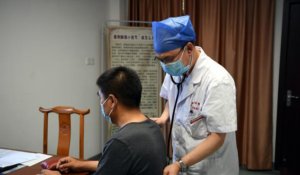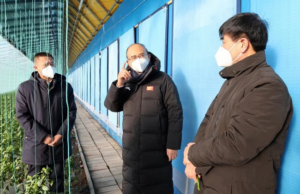
Chongqing issued 12 new rules of epidemic prevention for “B class B management” and gave “health kits” to the city’s elderly over 60 years old
January 3, Chongqing Municipal Government Information Office held a press conference on the prevention and control of the new crown infection, the Chongqing Municipal Government Deputy Secretary General, spokesman Yang Lin introduced the relevant information.
Yang Lin introduced, in accordance with the decision of the Party Central Committee, the State Council and the unified arrangements of the State Council joint prevention and control mechanism, combined with the actual situation in Chongqing, around the “health, prevention of serious illness, reduce mortality, risk prevention”, the city epidemic prevention and control command formulated the “Chongqing new coronavirus infection” category B B management “The implementation plan for the new coronavirus infection in Chongqing, as well as five special programs for epidemic surveillance, testing, prevention and control guidelines, personal protection guidelines, and prevention and control training, has been optimized in two main areas.
First, the prevention and control measures are adjusted with a focus on the elderly, maternal and infant children. There are 12 main areas of measures.
Strengthen the allocation of medical resources. Maintain 24-hour access to existing fever clinics in medical institutions above the second level and primary health care institutions. Equip township health centers and community health service centers with adequate ventilators, ambulances and other facilities and equipment. Continue to strengthen the allocation of ICU beds in the sub-region and reach at least 1 ICU bed per 10,000 people by district and county. Further strengthen the construction of intensive care wards, fully equipped with facilities and equipment and rescue and treatment forces. Strengthen the monitoring of the use of medical resources.
Guarantee the production and supply of drugs and testing reagents. Strengthen demand monitoring, ensure production and accurate supply, increase physical reserves in medical institutions, and provide free “health kits” to the city’s elderly over 60 years old in conjunction with family doctor contracting and grassroots public services. By expanding the production capacity of relevant drugs in Chongqing, increase procurement outside the city and upward support. At present, there are sufficient stocks of antipyretic drugs for children in medical institutions, antipyretic and analgesic drugs, antiviral drugs, cough medicines and Chinese medicines to meet basic needs, and the contradiction between supply and demand in the market of antigen detection reagents and medical N95 masks continues to ease. The districts and counties have ordered 2,448,000 “health kits”, and will subsequently increase the amount ordered and distributed in accordance with the city’s unified requirements.
Treatment of patients at different levels. Implementing health services for patients at home, strengthening health monitoring and medication guidance in primary care institutions, and improving the treatment of patients with basic diseases and timely referral of patients with serious illnesses. The primary care system will be implemented, and a mechanism will be established to give priority to senior patients. Establish municipal and district and county experts in the treatment of serious illnesses to make regular rounds and consult patients with serious and critical illnesses in a timely manner. Move the gates of serious illness prevention forward to families and communities, and strengthen health monitoring of vulnerable groups, especially elderly people living alone. Establish an inter-regional support mechanism within the city and form municipal inter-regional support teams to ensure smooth and orderly medical services.
Strengthen epidemic prevention and control in rural areas. Implement the responsibility of secretaries at all levels to grasp the prevention and control of epidemics in rural areas, effectively implement all measures of epidemic prevention and control to villages and households, and guarantee the supply of medicines in rural areas. Establish a responsibility system for tertiary hospitals in terms of zoning, open referral channels for acute and critical illnesses, and provide medical care for high-risk groups such as the elderly and patients with chronic basic diseases in rural areas. Widely carry out party cadres, family doctors into the home to door-to-door health service activities, to solve the difficulties of the masses to seek medical care and medication.
Do a good job of funeral service protection. Establish and improve the coordination and support mechanism for funeral services at the urban and municipal levels. Establish docking mechanisms with district and county long hotlines, 110 and key hospitals, elderly institutions and other units to respond to the needs of the public in a timely manner and maximize the protection capacity. Crack down on funeral service “scalpers”, “black intermediaries” and other chaos.
Accelerate the new coronavirus vaccination for the elderly. Promote enhanced immunization for high-risk groups, the elderly, people with more serious underlying diseases and people with low immunity. Scientific assessment of contraindications to vaccination will be conducted to ensure that all vaccinations are received, and vaccine coverage will be improved, especially for the elderly aged 60 and above. According to the national work plan, by the end of January 2023, the vaccination rate of the first dose of the new coronavirus vaccine for people aged 80 years and above in each district and county will reach 90%, and the vaccination rate of the entire vaccination and booster vaccination for eligible target groups will reach 90%. The vaccination rate of the entire vaccination and booster vaccination for eligible target groups aged 60-79 years will reach 95%. At present, there are still gaps in the rate of booster immunization for people aged 60-79 and the rate of first dose and booster immunization for people aged 80 and above in Chongqing, so we need to work together to build an immunization barrier.
Do a good job of health survey services for key populations. Comprehensively map the combined underlying diseases of people aged 65 and above and their new coronavirus vaccination status. Implement graded and classified services for key populations in the city, strengthening early identification and early intervention around the elderly and other high-risk populations, providing drugs, antigen testing, and contacting higher-level hospitals.
Strengthen the prevention and control of key institutions. Continue to strengthen the prevention and control of the epidemic in key places such as elderly institutions, social welfare institutions, medical institutions, prisons, schools, large enterprises, and party and government agencies to minimize the impact on normal production, life and teaching order.
Adjust the population testing strategy. Advocate non-essential non-testing, no longer carry out full nucleic acid screening, no longer carry out regular nucleic acid testing for personnel in direct contact with incoming personnel, articles, and the environment, as well as for staff in centralized isolation sites and employees in key industries, and implement categorized testing for key personnel. Keep an appropriate amount of convenient nucleic acid sampling points in the community to meet the needs of residents “willing to test as much as possible”.
Optimize the management of inbound personnel. Nucleic acid testing will be conducted within 48 hours before the entry from Chongqing port, and those with negative results can come back to Chongqing; if they are positive, they should come back to Chongqing after turning negative. No longer the full nucleic acid testing and centralized isolation of inbound personnel, the health declaration is normal and no abnormalities in the customs port routine quarantine, can be released into the social side; health declaration of abnormal or fever and other symptoms of the personnel by the customs antigen testing, the results are positive, can take home health monitoring or medical treatment. Resume outbound travel for Chongqing residents in an orderly manner.
Strengthen epidemic monitoring and response. Organize regular monitoring and early warning, scientifically study and judge the epidemic situation, comprehensively assess the epidemic intensity, medical resource load and social operation, etc., and adjust preventive and control measures in a timely manner. Complete timely genetic sequencing of inbound persons, severe cases, fatal cases and sentinel hospital surveillance samples to assess virus mutation.
Strengthen information dissemination and public education. Regularly release information on the outbreak and no longer distinguish between indigenous and imported cases from abroad. Strengthen health behavior guidance for residents, advocate keeping interpersonal distance in public places, minimize visits to crowded places for elderly people with underlying diseases and pregnant women and children, and consciously monitor the health of asymptomatic infected people and light cases at home. Reasonable use of drugs, scientific rehabilitation and fitness activities.
Second, refine the relevant supporting measures. Yang Lin introduced, on the basis of the Chongqing implementation plan, relevant departments have developed five special work programs for epidemic monitoring, detection, prevention and control guidelines, personal protection guidelines, prevention and control training. Timely and dynamic grasp of the level of incidence of infection and changing trends in the Chongqing population, scientific research and prediction of the epidemic scale, intensity and epidemic time, to provide technical support for the prevention and control of the epidemic; classification of different groups to adopt nucleic acid and antigen detection strategies, timely detection of serious illnesses in high-risk groups of infected people; for key populations, key institutions, key places, to clarify targeted prevention and control measures; around the daily behavior of individuals Clarify the code of conduct; administrative, professional and technical and related staff to implement graded training to master the policy and enhance capacity.
Yang Lin said that the new coronavirus epidemic prevention and control from “Class B A management” to “Class B B management”, the adjustment is the “management” level, never “The adjustment is the direction of “control”, from “prevention of infection” to “health protection, prevention of serious illness”. The adjustment is the direction of “management”, from “prevention of infection” to “health protection, prevention of serious illness.
Yang Lin also called on everyone to continue to adhere to the good personal hygiene habits and healthy lifestyles developed in the past three years, such as wearing masks, washing hands frequently, ventilating more, using public chopsticks, and not relaxing to do a good job of personal protective measures, guarding their own health and the health of their families, and jointly promoting the overall plan of “Class B B management” to be put into practice.


Average Rating